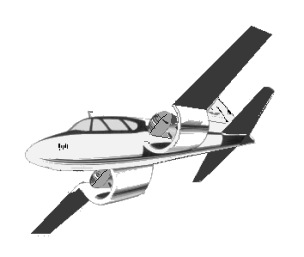Custer CCW-5 on:
[Wikipedia]
[Google]
[Amazon]
The Custer CCW-5 was a twin-engined, 5-seat aircraft of pusher configuration, which used a
/ref> The CCW-5 retained the fuselage and empennage of the Brigadier, but replaced the whole center section with a pair of channels, starting at roots in the lower part of the fuselage. Only beyond the channels did the conventional wings regain their mid-wing configuration. A
The CCW-5 retained the fuselage and empennage of the Brigadier, but replaced the whole center section with a pair of channels, starting at roots in the lower part of the fuselage. Only beyond the channels did the conventional wings regain their mid-wing configuration. A

channel wing
The channel wing is an aircraft wing principle developed by Willard Ray Custer in the 1920s. The most important part of the wing consists of a half-tube with an engine placed in the middle, driving a propeller placed at the rear end of the cha ...
claimed to enable low speed flight and short take-offs. Two CCW-5s flew, eleven years apart, but the type never entered production.
The aircraft was the third and last of a series of Custer Channel Wing
The Custer Channel Wing was a series of United States, American-built experimental aircraft designs of the 1940s and 1950s incorporating a ''half-barrel'' shaped section to each wing.
The channel wing principle
In 1925, Willard Custer noticed ...
designs.
Design and development
In most situations an aircraft's lift comes chiefly from the low pressure generated on the upper surface by the locally enhanced higher air velocity. This latter may be the result of the movement of the aircraft through the air or, when lift at low air speeds is important for short take-off performance, produced by engine power. The channel wing, the brainchild of Willard Ray Custer, is an example of the latter, where the air velocity over the upper surface velocity in a U-shaped channel formed out of the wing was increased with a pusher propeller at the trailing edge. This near semi-circular channel laterally constrained the airflow produced by the propeller, even when the aircraft was at rest, producing higher flow velocities than over a conventional pusher wing. The need for wing mounted pusher engines made a pusher twin a natural configuration, and for his third channel wing design Custer chose to modify the existing Baumann Brigadier, a 5-seat mid wing pusher twin which itself did not reach production.Aerofiles :Custer/ref>
 The CCW-5 retained the fuselage and empennage of the Brigadier, but replaced the whole center section with a pair of channels, starting at roots in the lower part of the fuselage. Only beyond the channels did the conventional wings regain their mid-wing configuration. A
The CCW-5 retained the fuselage and empennage of the Brigadier, but replaced the whole center section with a pair of channels, starting at roots in the lower part of the fuselage. Only beyond the channels did the conventional wings regain their mid-wing configuration. A Continental O-470
The Continental O-470 engine is a family of carbureted and fuel-injected six-cylinder, horizontally opposed, air-cooled aircraft engines that was developed especially for use in light aircraft by Continental Motors. Engines designated "IO" ...
flat six engine was mounted on slender vertical and horizontal struts at the center of each the channels, on the mid-wing line. These drove constant speed pusher propellers. The main undercarriage was much shortened by mounting its legs on the outer part of the channel section; the Brigadier nosewheel was retained.
The first of two CCW-5s flew on 13 July 1953 and was piloted by Walker Davidson at Oxnard, California
Oxnard () is a city in Ventura County, California, United States. On California's South Coast, it is the most populous city in Ventura County and the 22nd-most-populous city in California. Incorporated in 1903, Oxnard lies approximately west ...
. It was reported to have completed its test flying by autumn 1956, when production was scheduled to begin. This did not happen, though a second aircraft flew in June 1964. The delay was partly the result of financial problems. The CCW-5 performed well below the original estimates with a maximum achieved speed of compared with an estimated . It was claimed that the aircraft could fly under control at and that it could take off with a load at 70% power in .
The second CCW-5 was finished in 1964 with Continental IO-470P engines; it survives and is under restoration at the Mid-Atlantic Air Museum, Reading, Pennsylvania.
Specifications

See also
Notes
References
* * * * {{Custer Channel Wing Corporation Channel-wing aircraft CCW-5 1950s United States civil utility aircraft Twin-engined pusher aircraft Aircraft first flown in 1953